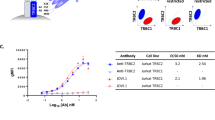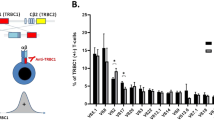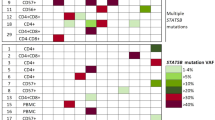Abstract
Reliable detection of clonal T cell receptor beta (TCRB) gene rearrangements is essential for clonality assessment of suspect T cell proliferations. Since no appropriate Southern blot probes were available, we developed a new set of optimized TCRB gene probes. The TCRBJ1 and TCRBJ2 probes are positioned just downstream of the Jβ1 and Jβ2 gene segments, respectively, and can be used for detection of both incomplete Dβ-Jβ and complete Vβ-Jβ rearrangements, whereas the TCRBD1U and TCRBD2U probes upstream of the Dβ segments can be used to confirm incomplete Dβ-Jβ rearrangements. Less frequently occurring Vβ-Dβ rearrangements can easily be detected via the downstream TCRBD1 and TCRBD2 probes. Although both EcoRI and HindIII are appropriate restriction enzymes to be used in combination with all these probes, false-positivity due to partial digestion of the EcoRI site in the Jβ2-Cβ intron has to be excluded via the TCRBC probe. Application of the TCRB probes in a large series of nearly 200 T cell malignancies revealed clonal rearrangements in all immature and mature TCRαβ+ T cell malignancies, in the vast majority of TCRγδ+ T cell acute lymphoblastic leukemias (T-ALL) (approximately 95%) and even in most CD3− T-ALL (approximately 80%). TCRB gene rearrangement patterns differed between the various categories of T cell malignancies. An increased frequency of complete Vβ-Jβ1 rearrangements was observed in TCRαβ+ T-ALL as compared to CD3− and TCRγδ+ T-ALL (33% vs16% and 11%, respectively), and also incompletely rearranged V-D, D-D, or D-J alleles in the β2 region occurred more frequently in TCRαβ+ cases than in CD3−and TCRγδ+ T-ALL (27% vs 15% and 18%, respectively). Furthermore, in comparison to TCRαβ+ T-ALL, less Vβ-Jβ1 and more Vβ-Jβ2 rearrangements were detected in mature TCRαβ+ T cell malignancies. The occurrence of the different types of TCRB rearrangement patterns has implications for PCR-based clonality assessment and for PCR-based detection of minimal residual disease via TCRB gene analysis. For instance, focussing on the β2 region of T-ALL will allow detection of rearrangements in 70%, 75%, and 90% of CD3−, TCRγδ+, and TCRαβ+ cases, respectively. Therefore the here-described results will facilitate the design of the most appropriate primer sets for PCR analysis of TCRB gene rearrangements at the DNA level.
This is a preview of subscription content, access via your institution
Access options
Subscribe to this journal
Receive 12 print issues and online access
$259.00 per year
only $21.58 per issue
Buy this article
- Purchase on Springer Link
- Instant access to full article PDF
Prices may be subject to local taxes which are calculated during checkout
Similar content being viewed by others
Author information
Authors and Affiliations
Rights and permissions
About this article
Cite this article
Langerak, A., Wolvers-Tettero, I. & van Dongen, J. Detection of T cell receptor beta (TCRB) gene rearrangement patterns in T cell malignancies by Southern blot analysis. Leukemia 13, 965–974 (1999). https://doi.org/10.1038/sj.leu.2401427
Received:
Accepted:
Published:
Issue Date:
DOI: https://doi.org/10.1038/sj.leu.2401427
Keywords
This article is cited by
-
Clonality testing of cutaneous lymphoid infiltrates: practicalities, pitfalls and potential uses
Journal of Hematopathology (2012)
-
An improved design of PCR primers for detection of human T cell receptor β chain repertoire
Molecular Biology Reports (2009)
-
BMI1 as oncogenic candidate in a novel TCRB-associated chromosomal aberration in a patient with TCRγδ+ T-cell acute lymphoblastic leukemia
Leukemia (2008)
-
Human T-cell lines with well-defined T-cell receptor gene rearrangements as controls for the BIOMED-2 multiplex polymerase chain reaction tubes
Leukemia (2007)
-
Improved reliability of lymphoma diagnostics via PCR-based clonality testing: — Report of the BIOMED-2 Concerted Action BHM4-CT98-3936
Leukemia (2007)



